display JEEP GRAND CHEROKEE 2020 Owner handbook (in English)
[x] Cancel search | Manufacturer: JEEP, Model Year: 2020, Model line: GRAND CHEROKEE, Model: JEEP GRAND CHEROKEE 2020Pages: 378, PDF Size: 6.88 MB
Page 53 of 378
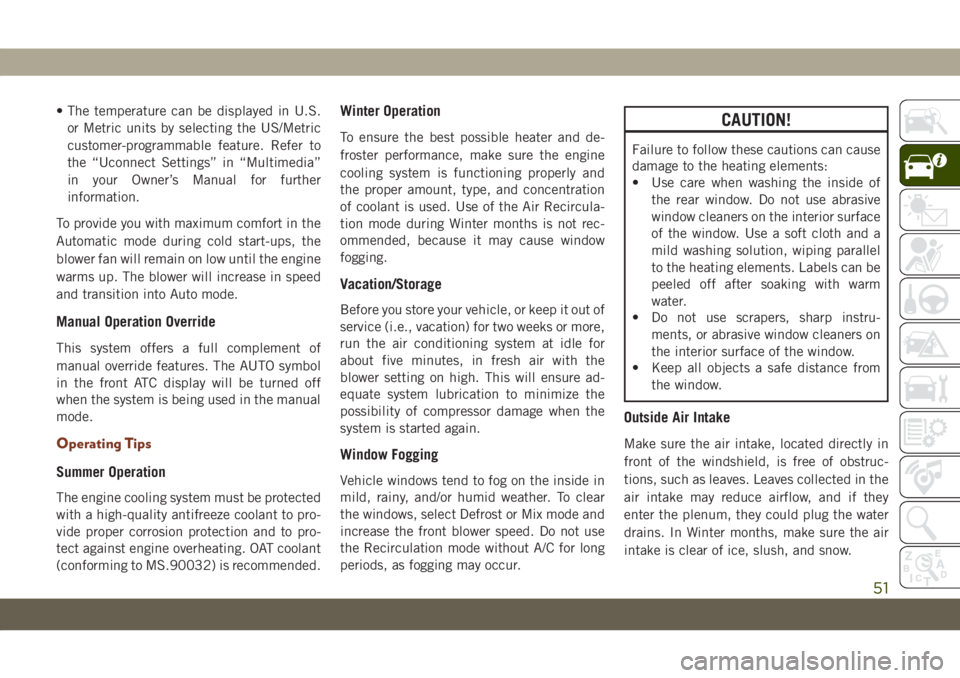
• The temperature can be displayed in U.S.
or Metric units by selecting the US/Metric
customer-programmable feature. Refer to
the “Uconnect Settings” in “Multimedia”
in your Owner’s Manual for further
information.
To provide you with maximum comfort in the
Automatic mode during cold start-ups, the
blower fan will remain on low until the engine
warms up. The blower will increase in speed
and transition into Auto mode.
Manual Operation Override
This system offers a full complement of
manual override features. The AUTO symbol
in the front ATC display will be turned off
when the system is being used in the manual
mode.
Operating Tips
Summer Operation
The engine cooling system must be protected
with a high-quality antifreeze coolant to pro-
vide proper corrosion protection and to pro-
tect against engine overheating. OAT coolant
(conforming to MS.90032) is recommended.
Winter Operation
To ensure the best possible heater and de-
froster performance, make sure the engine
cooling system is functioning properly and
the proper amount, type, and concentration
of coolant is used. Use of the Air Recircula-
tion mode during Winter months is not rec-
ommended, because it may cause window
fogging.
Vacation/Storage
Before you store your vehicle, or keep it out of
service (i.e., vacation) for two weeks or more,
run the air conditioning system at idle for
about five minutes, in fresh air with the
blower setting on high. This will ensure ad-
equate system lubrication to minimize the
possibility of compressor damage when the
system is started again.
Window Fogging
Vehicle windows tend to fog on the inside in
mild, rainy, and/or humid weather. To clear
the windows, select Defrost or Mix mode and
increase the front blower speed. Do not use
the Recirculation mode without A/C for long
periods, as fogging may occur.
CAUTION!
Failure to follow these cautions can cause
damage to the heating elements:
• Use care when washing the inside of
the rear window. Do not use abrasive
window cleaners on the interior surface
of the window. Use a soft cloth and a
mild washing solution, wiping parallel
to the heating elements. Labels can be
peeled off after soaking with warm
water.
• Do not use scrapers, sharp instru-
ments, or abrasive window cleaners on
the interior surface of the window.
• Keep all objects a safe distance from
the window.
Outside Air Intake
Make sure the air intake, located directly in
front of the windshield, is free of obstruc-
tions, such as leaves. Leaves collected in the
air intake may reduce airflow, and if they
enter the plenum, they could plug the water
drains. In Winter months, make sure the air
intake is clear of ice, slush, and snow.
51
Page 62 of 378
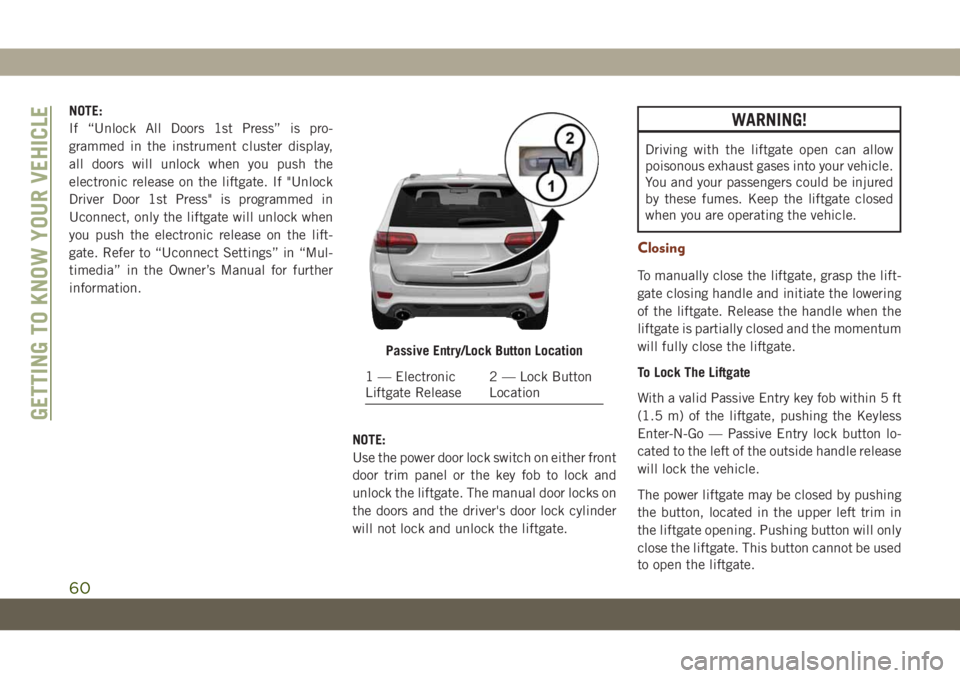
NOTE:
If “Unlock All Doors 1st Press” is pro-
grammed in the instrument cluster display,
all doors will unlock when you push the
electronic release on the liftgate. If "Unlock
Driver Door 1st Press" is programmed in
Uconnect, only the liftgate will unlock when
you push the electronic release on the lift-
gate. Refer to “Uconnect Settings” in “Mul-
timedia” in the Owner’s Manual for further
information.
NOTE:
Use the power door lock switch on either front
door trim panel or the key fob to lock and
unlock the liftgate. The manual door locks on
the doors and the driver's door lock cylinder
will not lock and unlock the liftgate.WARNING!
Driving with the liftgate open can allow
poisonous exhaust gases into your vehicle.
You and your passengers could be injured
by these fumes. Keep the liftgate closed
when you are operating the vehicle.
Closing
To manually close the liftgate, grasp the lift-
gate closing handle and initiate the lowering
of the liftgate. Release the handle when the
liftgate is partially closed and the momentum
will fully close the liftgate.
To Lock The Liftgate
With a valid Passive Entry key fob within 5 ft
(1.5 m) of the liftgate, pushing the Keyless
Enter-N-Go — Passive Entry lock button lo-
cated to the left of the outside handle release
will lock the vehicle.
The power liftgate may be closed by pushing
the button, located in the upper left trim in
the liftgate opening. Pushing button will only
close the liftgate. This button cannot be used
to open the liftgate.
Passive Entry/Lock Button Location
1 — Electronic
Liftgate Release2 — Lock Button
Location
GETTING TO KNOW YOUR VEHICLE
60
Page 68 of 378
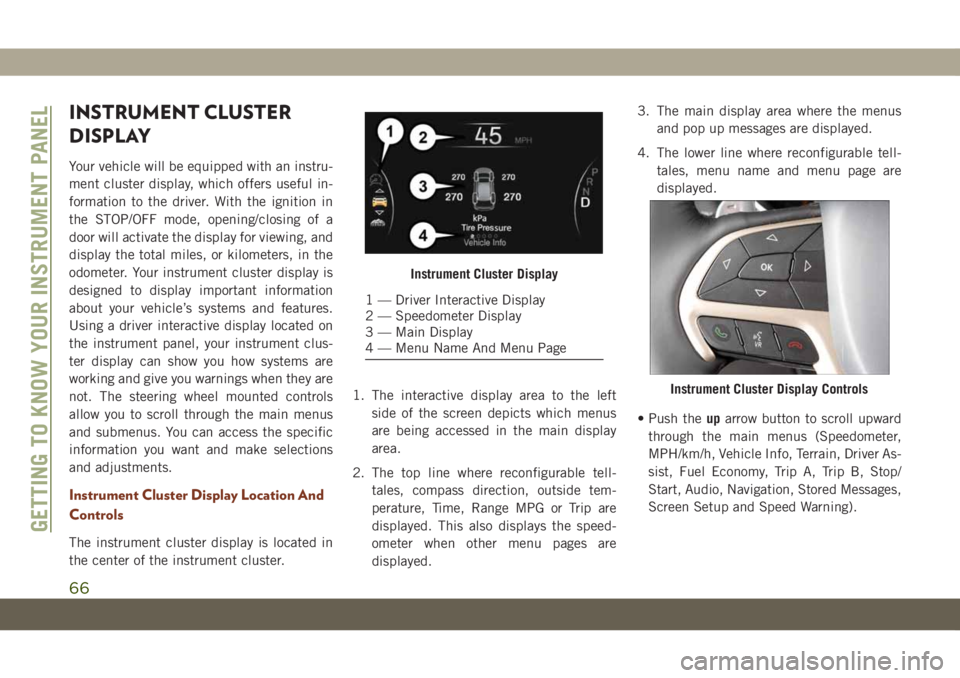
INSTRUMENT CLUSTER
DISPLAY
Your vehicle will be equipped with an instru-
ment cluster display, which offers useful in-
formation to the driver. With the ignition in
the STOP/OFF mode, opening/closing of a
door will activate the display for viewing, and
display the total miles, or kilometers, in the
odometer. Your instrument cluster display is
designed to display important information
about your vehicle’s systems and features.
Using a driver interactive display located on
the instrument panel, your instrument clus-
ter display can show you how systems are
working and give you warnings when they are
not. The steering wheel mounted controls
allow you to scroll through the main menus
and submenus. You can access the specific
information you want and make selections
and adjustments.
Instrument Cluster Display Location And
Controls
The instrument cluster display is located in
the center of the instrument cluster.1. The interactive display area to the left
side of the screen depicts which menus
are being accessed in the main display
area.
2. The top line where reconfigurable tell-
tales, compass direction, outside tem-
perature, Time, Range MPG or Trip are
displayed. This also displays the speed-
ometer when other menu pages are
displayed.3. The main display area where the menus
and pop up messages are displayed.
4. The lower line where reconfigurable tell-
tales, menu name and menu page are
displayed.
• Push theuparrow button to scroll upward
through the main menus (Speedometer,
MPH/km/h, Vehicle Info, Terrain, Driver As-
sist, Fuel Economy, Trip A, Trip B, Stop/
Start, Audio, Navigation, Stored Messages,
Screen Setup and Speed Warning).
Instrument Cluster Display
1 — Driver Interactive Display
2 — Speedometer Display
3 — Main Display
4 — Menu Name And Menu Page
Instrument Cluster Display Controls
GETTING TO KNOW YOUR INSTRUMENT PANEL
66
Page 69 of 378
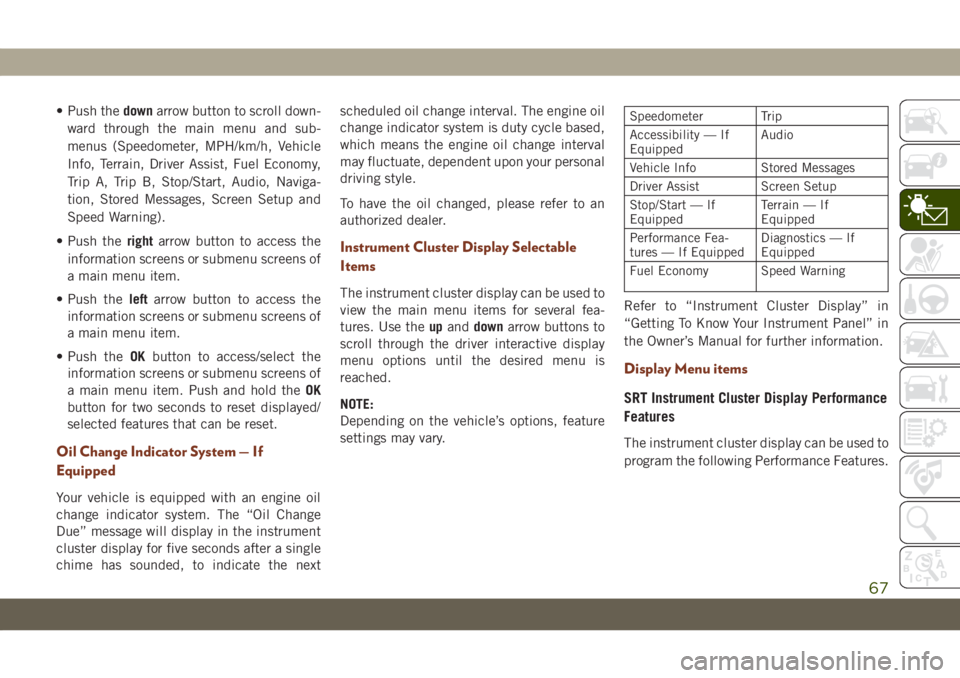
• Push thedownarrow button to scroll down-
ward through the main menu and sub-
menus (Speedometer, MPH/km/h, Vehicle
Info, Terrain, Driver Assist, Fuel Economy,
Trip A, Trip B, Stop/Start, Audio, Naviga-
tion, Stored Messages, Screen Setup and
Speed Warning).
• Push therightarrow button to access the
information screens or submenu screens of
a main menu item.
• Push theleftarrow button to access the
information screens or submenu screens of
a main menu item.
• Push theOKbutton to access/select the
information screens or submenu screens of
a main menu item. Push and hold theOK
button for two seconds to reset displayed/
selected features that can be reset.
Oil Change Indicator System — If
Equipped
Your vehicle is equipped with an engine oil
change indicator system. The “Oil Change
Due” message will display in the instrument
cluster display for five seconds after a single
chime has sounded, to indicate the nextscheduled oil change interval. The engine oil
change indicator system is duty cycle based,
which means the engine oil change interval
may fluctuate, dependent upon your personal
driving style.
To have the oil changed, please refer to an
authorized dealer.
Instrument Cluster Display Selectable
Items
The instrument cluster display can be used to
view the main menu items for several fea-
tures. Use theupanddownarrow buttons to
scroll through the driver interactive display
menu options until the desired menu is
reached.
NOTE:
Depending on the vehicle’s options, feature
settings may vary.
Speedometer Trip
Accessibility — If
EquippedAudio
Vehicle Info Stored Messages
Driver Assist Screen Setup
Stop/Start — If
EquippedTerrain — If
Equipped
Performance Fea-
tures — If EquippedDiagnostics — If
Equipped
Fuel Economy Speed Warning
Refer to “Instrument Cluster Display” in
“Getting To Know Your Instrument Panel” in
the Owner’s Manual for further information.
Display Menu items
SRT Instrument Cluster Display Performance
Features
The instrument cluster display can be used to
program the following Performance Features.
67
Page 70 of 378
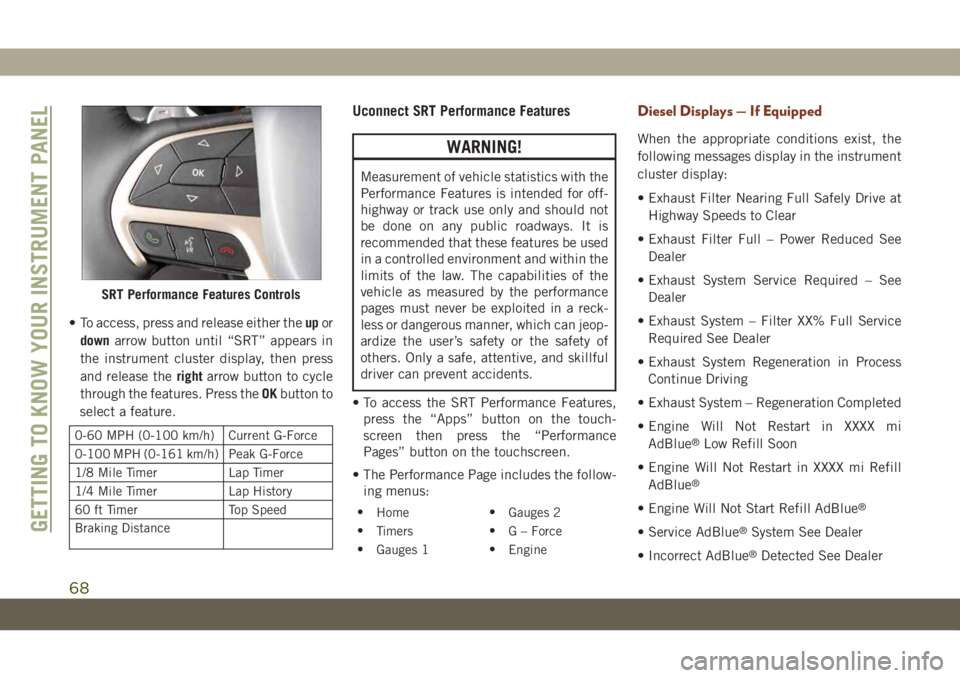
• To access, press and release either theupor
downarrow button until “SRT” appears in
the instrument cluster display, then press
and release therightarrow button to cycle
through the features. Press theOKbutton to
select a feature.
0-60 MPH (0-100 km/h) Current G-Force
0-100 MPH (0-161 km/h) Peak G-Force
1/8 Mile Timer Lap Timer
1/4 Mile Timer Lap History
60 ft Timer Top Speed
Braking Distance
Uconnect SRT Performance Features
WARNING!
Measurement of vehicle statistics with the
Performance Features is intended for off-
highway or track use only and should not
be done on any public roadways. It is
recommended that these features be used
in a controlled environment and within the
limits of the law. The capabilities of the
vehicle as measured by the performance
pages must never be exploited in a reck-
less or dangerous manner, which can jeop-
ardize the user’s safety or the safety of
others. Only a safe, attentive, and skillful
driver can prevent accidents.
• To access the SRT Performance Features,
press the “Apps” button on the touch-
screen then press the “Performance
Pages” button on the touchscreen.
• The Performance Page includes the follow-
ing menus:
•
Home•
Gauges 2
•
Timers•
G – Force
•
Gauges 1•
Engine
Diesel Displays — If Equipped
When the appropriate conditions exist, the
following messages display in the instrument
cluster display:
• Exhaust Filter Nearing Full Safely Drive at
Highway Speeds to Clear
• Exhaust Filter Full – Power Reduced See
Dealer
• Exhaust System Service Required – See
Dealer
• Exhaust System – Filter XX% Full Service
Required See Dealer
• Exhaust System Regeneration in Process
Continue Driving
• Exhaust System – Regeneration Completed
• Engine Will Not Restart in XXXX mi
AdBlue
®Low Refill Soon
• Engine Will Not Restart in XXXX mi Refill
AdBlue
®
• Engine Will Not Start Refill AdBlue®
• Service AdBlue®System See Dealer
• Incorrect AdBlue
®Detected See Dealer
SRT Performance Features Controls
GETTING TO KNOW YOUR INSTRUMENT PANEL
68
Page 71 of 378
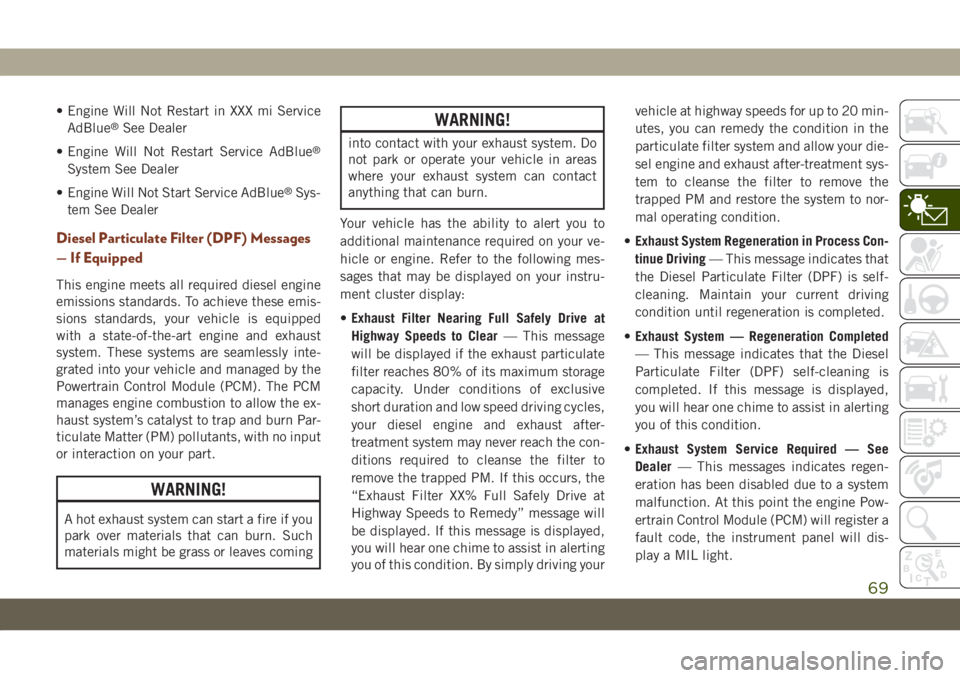
• Engine Will Not Restart in XXX mi Service
AdBlue®See Dealer
• Engine Will Not Restart Service AdBlue
®
System See Dealer
• Engine Will Not Start Service AdBlue
®Sys-
tem See Dealer
Diesel Particulate Filter (DPF) Messages
— If Equipped
This engine meets all required diesel engine
emissions standards. To achieve these emis-
sions standards, your vehicle is equipped
with a state-of-the-art engine and exhaust
system. These systems are seamlessly inte-
grated into your vehicle and managed by the
Powertrain Control Module (PCM). The PCM
manages engine combustion to allow the ex-
haust system’s catalyst to trap and burn Par-
ticulate Matter (PM) pollutants, with no input
or interaction on your part.
WARNING!
A hot exhaust system can start a fire if you
park over materials that can burn. Such
materials might be grass or leaves coming
WARNING!
into contact with your exhaust system. Do
not park or operate your vehicle in areas
where your exhaust system can contact
anything that can burn.
Your vehicle has the ability to alert you to
additional maintenance required on your ve-
hicle or engine. Refer to the following mes-
sages that may be displayed on your instru-
ment cluster display:
•Exhaust Filter Nearing Full Safely Drive at
Highway Speeds to Clear— This message
will be displayed if the exhaust particulate
filter reaches 80% of its maximum storage
capacity. Under conditions of exclusive
short duration and low speed driving cycles,
your diesel engine and exhaust after-
treatment system may never reach the con-
ditions required to cleanse the filter to
remove the trapped PM. If this occurs, the
“Exhaust Filter XX% Full Safely Drive at
Highway Speeds to Remedy” message will
be displayed. If this message is displayed,
you will hear one chime to assist in alerting
you of this condition. By simply driving yourvehicle at highway speeds for up to 20 min-
utes, you can remedy the condition in the
particulate filter system and allow your die-
sel engine and exhaust after-treatment sys-
tem to cleanse the filter to remove the
trapped PM and restore the system to nor-
mal operating condition.
•Exhaust System Regeneration in Process Con-
tinue Driving— This message indicates that
the Diesel Particulate Filter (DPF) is self-
cleaning. Maintain your current driving
condition until regeneration is completed.
•Exhaust System — Regeneration Completed
— This message indicates that the Diesel
Particulate Filter (DPF) self-cleaning is
completed. If this message is displayed,
you will hear one chime to assist in alerting
you of this condition.
•Exhaust System Service Required — See
Dealer— This messages indicates regen-
eration has been disabled due to a system
malfunction. At this point the engine Pow-
ertrain Control Module (PCM) will register a
fault code, the instrument panel will dis-
play a MIL light.
69
Page 73 of 378
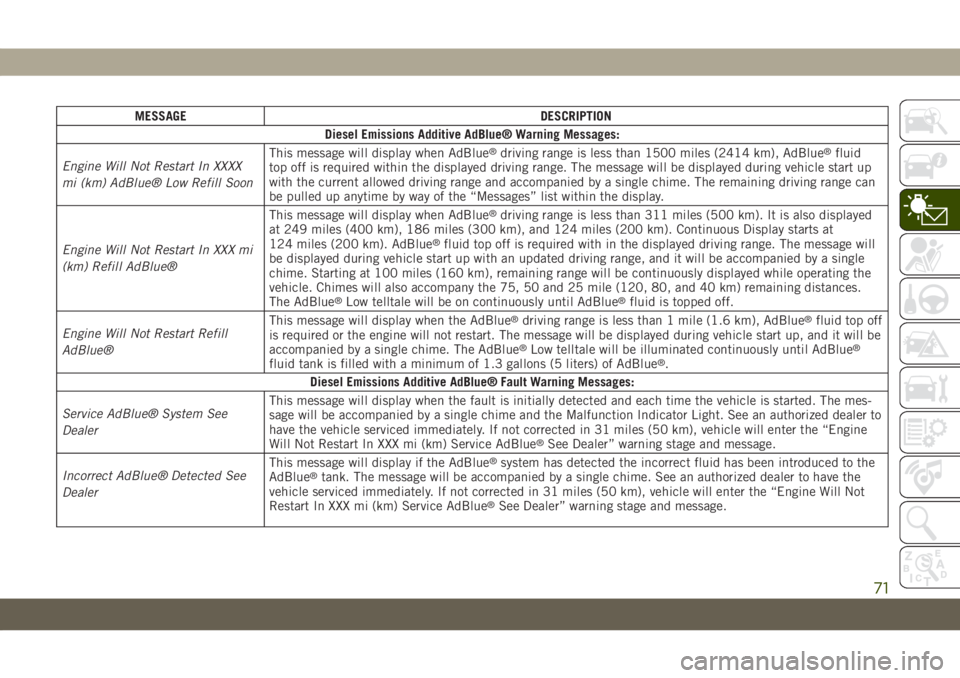
MESSAGE DESCRIPTION
Diesel Emissions Additive AdBlue® Warning Messages:
Engine Will Not Restart In XXXX
mi (km) AdBlue® Low Refill SoonThis message will display when AdBlue
®driving range is less than 1500 miles (2414 km), AdBlue®fluid
top off is required within the displayed driving range. The message will be displayed during vehicle start up
with the current allowed driving range and accompanied by a single chime. The remaining driving range can
be pulled up anytime by way of the “Messages” list within the display.
Engine Will Not Restart In XXX mi
(km) Refill AdBlue®This message will display when AdBlue
®driving range is less than 311 miles (500 km). It is also displayed
at 249 miles (400 km), 186 miles (300 km), and 124 miles (200 km). Continuous Display starts at
124 miles (200 km). AdBlue
®fluid top off is required with in the displayed driving range. The message will
be displayed during vehicle start up with an updated driving range, and it will be accompanied by a single
chime. Starting at 100 miles (160 km), remaining range will be continuously displayed while operating the
vehicle. Chimes will also accompany the 75, 50 and 25 mile (120, 80, and 40 km) remaining distances.
The AdBlue
®Low telltale will be on continuously until AdBlue®fluid is topped off.
Engine Will Not Restart Refill
AdBlue®This message will display when the AdBlue®driving range is less than 1 mile (1.6 km), AdBlue®fluid top off
is required or the engine will not restart. The message will be displayed during vehicle start up, and it will be
accompanied by a single chime. The AdBlue
®Low telltale will be illuminated continuously until AdBlue®
fluid tank is filled with a minimum of 1.3 gallons (5 liters) of AdBlue®.
Diesel Emissions Additive AdBlue® Fault Warning Messages:
Service AdBlue® System See
DealerThis message will display when the fault is initially detected and each time the vehicle is started. The mes-
sage will be accompanied by a single chime and the Malfunction Indicator Light. See an authorized dealer to
have the vehicle serviced immediately. If not corrected in 31 miles (50 km), vehicle will enter the “Engine
Will Not Restart In XXX mi (km) Service AdBlue
®See Dealer” warning stage and message.
Incorrect AdBlue® Detected See
DealerThis message will display if the AdBlue®system has detected the incorrect fluid has been introduced to the
AdBlue®tank. The message will be accompanied by a single chime. See an authorized dealer to have the
vehicle serviced immediately. If not corrected in 31 miles (50 km), vehicle will enter the “Engine Will Not
Restart In XXX mi (km) Service AdBlue
®See Dealer” warning stage and message.
71
Page 74 of 378
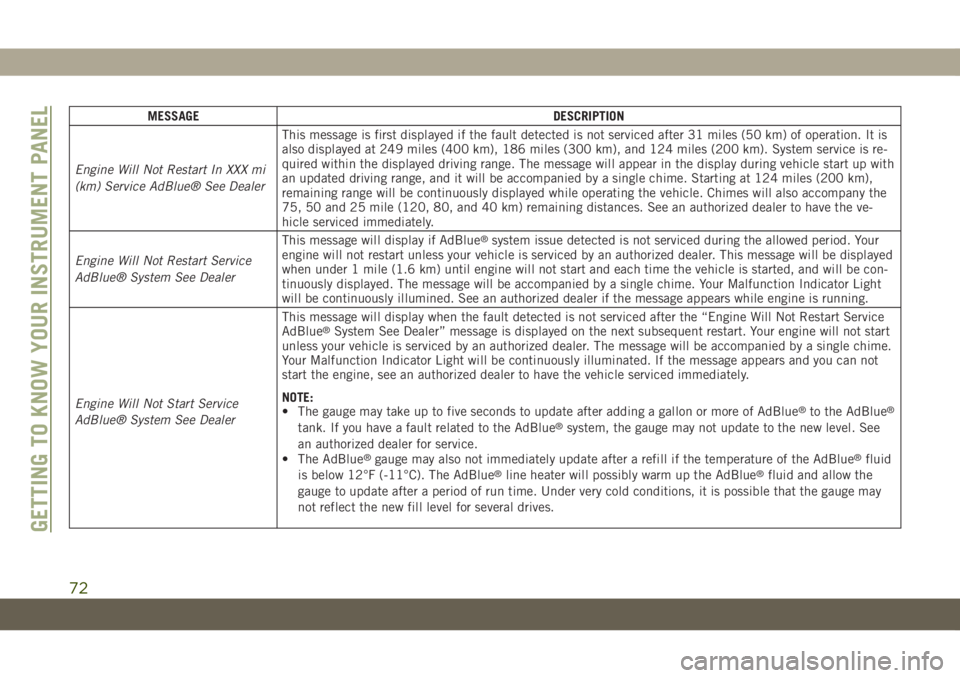
MESSAGE DESCRIPTION
Engine Will Not Restart In XXX mi
(km) Service AdBlue® See DealerThis message is first displayed if the fault detected is not serviced after 31 miles (50 km) of operation. It is
also displayed at 249 miles (400 km), 186 miles (300 km), and 124 miles (200 km). System service is re-
quired within the displayed driving range. The message will appear in the display during vehicle start up with
an updated driving range, and it will be accompanied by a single chime. Starting at 124 miles (200 km),
remaining range will be continuously displayed while operating the vehicle. Chimes will also accompany the
75, 50 and 25 mile (120, 80, and 40 km) remaining distances. See an authorized dealer to have the ve-
hicle serviced immediately.
Engine Will Not Restart Service
AdBlue® System See DealerThis message will display if AdBlue
®system issue detected is not serviced during the allowed period. Your
engine will not restart unless your vehicle is serviced by an authorized dealer. This message will be displayed
when under 1 mile (1.6 km) until engine will not start and each time the vehicle is started, and will be con-
tinuously displayed. The message will be accompanied by a single chime. Your Malfunction Indicator Light
will be continuously illumined. See an authorized dealer if the message appears while engine is running.
Engine Will Not Start Service
AdBlue® System See DealerThis message will display when the fault detected is not serviced after the “Engine Will Not Restart Service
AdBlue
®System See Dealer” message is displayed on the next subsequent restart. Your engine will not start
unless your vehicle is serviced by an authorized dealer. The message will be accompanied by a single chime.
Your Malfunction Indicator Light will be continuously illuminated. If the message appears and you can not
start the engine, see an authorized dealer to have the vehicle serviced immediately.
NOTE:
• The gauge may take up to five seconds to update after adding a gallon or more of AdBlue
®to the AdBlue®
tank. If you have a fault related to the AdBlue®system, the gauge may not update to the new level. See
an authorized dealer for service.
• The AdBlue
®gauge may also not immediately update after a refill if the temperature of the AdBlue®fluid
is below 12°F (-11°C). The AdBlue®line heater will possibly warm up the AdBlue®fluid and allow the
gauge to update after a period of run time. Under very cold conditions, it is possible that the gauge may
not reflect the new fill level for several drives.
GETTING TO KNOW YOUR INSTRUMENT PANEL
72
Page 75 of 378
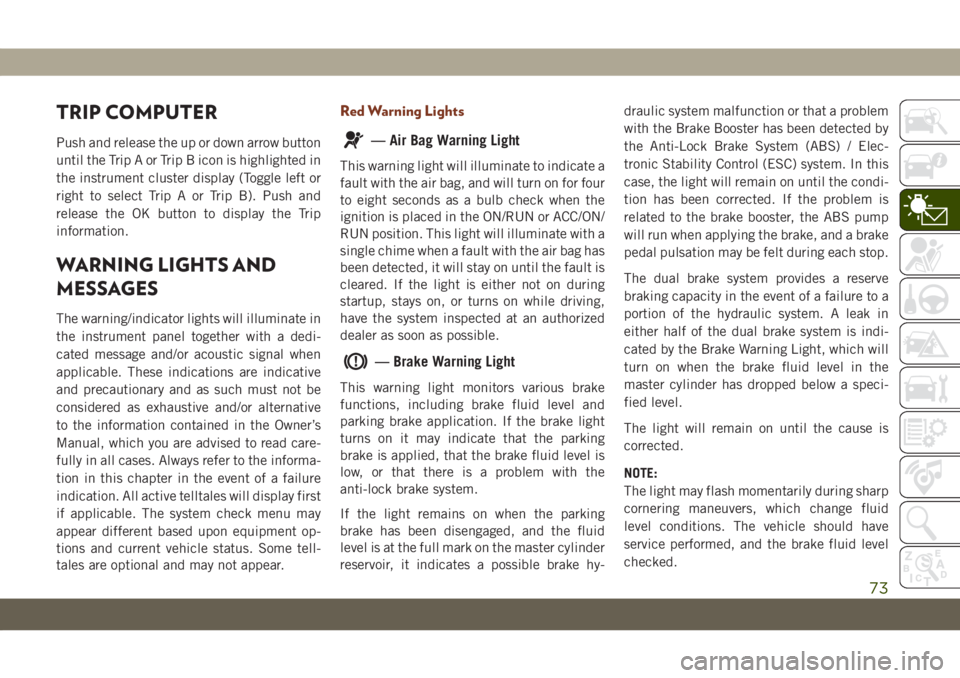
TRIP COMPUTER
Push and release the up or down arrow button
until the Trip A or Trip B icon is highlighted in
the instrument cluster display (Toggle left or
right to select Trip A or Trip B). Push and
release the OK button to display the Trip
information.
WARNING LIGHTS AND
MESSAGES
The warning/indicator lights will illuminate in
the instrument panel together with a dedi-
cated message and/or acoustic signal when
applicable. These indications are indicative
and precautionary and as such must not be
considered as exhaustive and/or alternative
to the information contained in the Owner’s
Manual, which you are advised to read care-
fully in all cases. Always refer to the informa-
tion in this chapter in the event of a failure
indication. All active telltales will display first
if applicable. The system check menu may
appear different based upon equipment op-
tions and current vehicle status. Some tell-
tales are optional and may not appear.
Red Warning Lights
— Air Bag Warning Light
This warning light will illuminate to indicate a
fault with the air bag, and will turn on for four
to eight seconds as a bulb check when the
ignition is placed in the ON/RUN or ACC/ON/
RUN position. This light will illuminate with a
single chime when a fault with the air bag has
been detected, it will stay on until the fault is
cleared. If the light is either not on during
startup, stays on, or turns on while driving,
have the system inspected at an authorized
dealer as soon as possible.
— Brake Warning Light
This warning light monitors various brake
functions, including brake fluid level and
parking brake application. If the brake light
turns on it may indicate that the parking
brake is applied, that the brake fluid level is
low, or that there is a problem with the
anti-lock brake system.
If the light remains on when the parking
brake has been disengaged, and the fluid
level is at the full mark on the master cylinder
reservoir, it indicates a possible brake hy-draulic system malfunction or that a problem
with the Brake Booster has been detected by
the Anti-Lock Brake System (ABS) / Elec-
tronic Stability Control (ESC) system. In this
case, the light will remain on until the condi-
tion has been corrected. If the problem is
related to the brake booster, the ABS pump
will run when applying the brake, and a brake
pedal pulsation may be felt during each stop.
The dual brake system provides a reserve
braking capacity in the event of a failure to a
portion of the hydraulic system. A leak in
either half of the dual brake system is indi-
cated by the Brake Warning Light, which will
turn on when the brake fluid level in the
master cylinder has dropped below a speci-
fied level.
The light will remain on until the cause is
corrected.
NOTE:
The light may flash momentarily during sharp
cornering maneuvers, which change fluid
level conditions. The vehicle should have
service performed, and the brake fluid level
checked.
73
Page 80 of 378
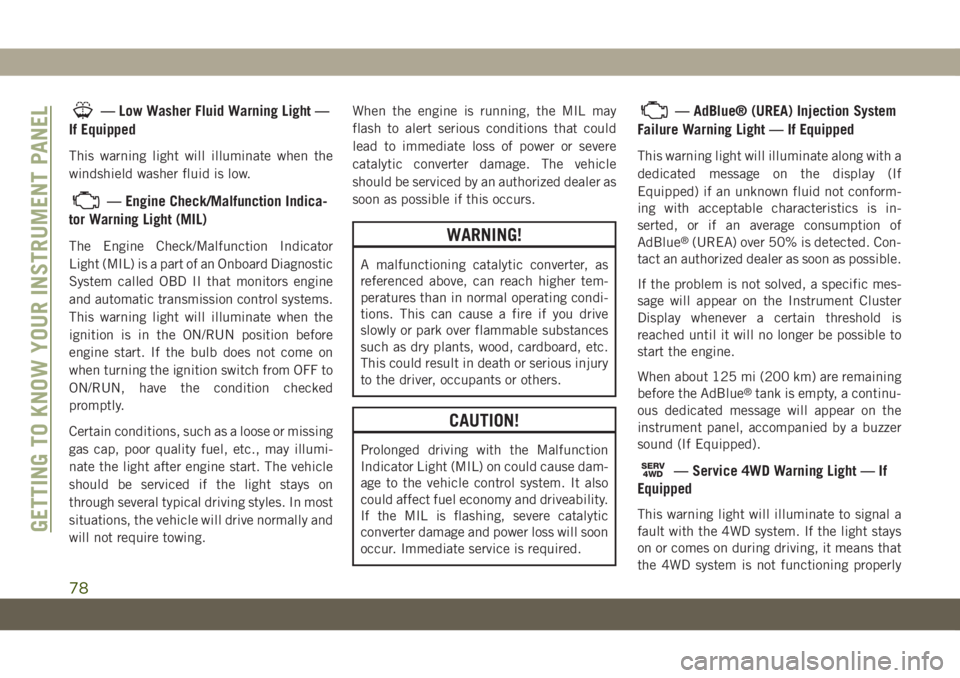
— Low Washer Fluid Warning Light —
If Equipped
This warning light will illuminate when the
windshield washer fluid is low.
— Engine Check/Malfunction Indica-
tor Warning Light (MIL)
The Engine Check/Malfunction Indicator
Light (MIL) is a part of an Onboard Diagnostic
System called OBD II that monitors engine
and automatic transmission control systems.
This warning light will illuminate when the
ignition is in the ON/RUN position before
engine start. If the bulb does not come on
when turning the ignition switch from OFF to
ON/RUN, have the condition checked
promptly.
Certain conditions, such as a loose or missing
gas cap, poor quality fuel, etc., may illumi-
nate the light after engine start. The vehicle
should be serviced if the light stays on
through several typical driving styles. In most
situations, the vehicle will drive normally and
will not require towing.When the engine is running, the MIL may
flash to alert serious conditions that could
lead to immediate loss of power or severe
catalytic converter damage. The vehicle
should be serviced by an authorized dealer as
soon as possible if this occurs.WARNING!
A malfunctioning catalytic converter, as
referenced above, can reach higher tem-
peratures than in normal operating condi-
tions. This can cause a fire if you drive
slowly or park over flammable substances
such as dry plants, wood, cardboard, etc.
This could result in death or serious injury
to the driver, occupants or others.
CAUTION!
Prolonged driving with the Malfunction
Indicator Light (MIL) on could cause dam-
age to the vehicle control system. It also
could affect fuel economy and driveability.
If the MIL is flashing, severe catalytic
converter damage and power loss will soon
occur. Immediate service is required.
— AdBlue® (UREA) Injection System
Failure Warning Light — If Equipped
This warning light will illuminate along with a
dedicated message on the display (If
Equipped) if an unknown fluid not conform-
ing with acceptable characteristics is in-
serted, or if an average consumption of
AdBlue
®(UREA) over 50% is detected. Con-
tact an authorized dealer as soon as possible.
If the problem is not solved, a specific mes-
sage will appear on the Instrument Cluster
Display whenever a certain threshold is
reached until it will no longer be possible to
start the engine.
When about 125 mi (200 km) are remaining
before the AdBlue
®tank is empty, a continu-
ous dedicated message will appear on the
instrument panel, accompanied by a buzzer
sound (If Equipped).
SERV4WD— Service 4WD Warning Light — If
Equipped
This warning light will illuminate to signal a
fault with the 4WD system. If the light stays
on or comes on during driving, it means that
the 4WD system is not functioning properlyGETTING TO KNOW YOUR INSTRUMENT PANEL
78